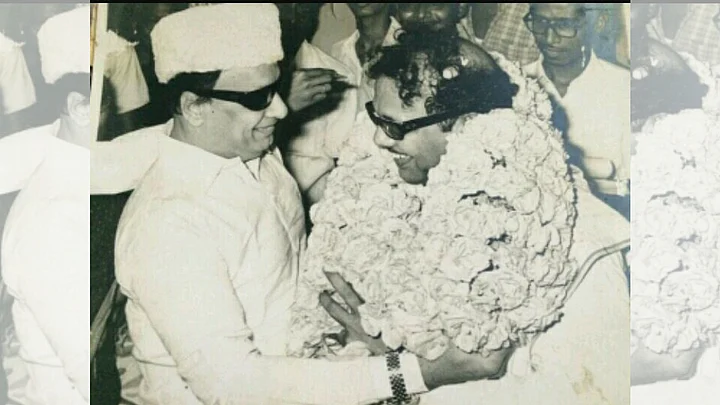MG Ramachandran and Sivaji Ganesan continue to be the biggest superstars of Tamil cinema. This holds true despite the fact that there was a Thyagaraja Bhagavathar before them, and a Rajinikanth after.
But MGR and Sivaji wouldn’t have had such a steep rise and the indelible place in the history of cinema that they did, if not for M Karunanidhi, the first and arguably greatest superstar screenwriter.
While his work as screenwriter was nothing short of genius, amidst the plethora of work he did, we try to bring you some great examples of his films.
1. Parasakthi, the Beginning
The mythological silent film based on the Mahabharata, Keechaka Vadham (1916), set the ball rolling for Tamil cinema. The introduction of sound didn't derail the one-track train of mythological films. Aimed specifically at the illiterate, each film would feature more than 40 songs, and he, who could sing them all in chaste Carnatic vocals, was the superstar.
All this changed in 1952, with a single monologue from the film Parasakthi. Featuring story and screenplay by M Karunanidhi, it paved the way for two phenomena that are both unique to Tamil cinema, and continue to hold sway over it:
- The use of cinema as a medium to broadcast political ideology
- The birth of dialogue/monologue-oriented entertainment
Even if you do not know the language, it is impossible to be blind (or deaf) to the sheer power of the monologue and Sivaji's intensity as he delivers it in one take.
Parasakthi was one of the most controversial films of the time, since it was an open proponent of Annadurai and Periyar’s Dravidian ideology; vehemently against Brahminism, Hindu culture, temple worship, etc and a celebration of a rise to arms against social evils.
Sample a bit of Karunanidhi in this dialogue:
Just because you came around chanting names and offered flowers to the stone, would it become a god?Sivaji Ganesan in ‘Parasakthi’; dialogues by M Karunanidhi
The dialogue was a tongue-in-cheek reference to the title of the film itself, Parasakthi, the Goddess. The film also featured a scene in which a priest tries to rape a woman.
Despite the Congress party's antagonism and a call to ban the film, the then Tamil Nadu CM C Rajagopalachari allowed it to be screened.
2. Manohara, Shakespeare Hear Hear!
Barely two years after Parasakthi, Karunanidhi made cinematic history, and struck gold at the box-office with another Sivaji Ganesan starrer, Manohara.
While its influence hasn't been recognised, the film is based on Shakespeare's Hamlet.
Sivaji Ganesan's memory for dialogue was prodigal. Kavithalaya Krishnan, a cinephile and former actor who worked under K Balachander recounts:
“The entire monologue, be it eight minutes or ten, would be read out by an assistant, while Sivaji dons make-up. Once the make-up was on, Sivaji was in character, and would deliver the entire dialogue in a single take.”
Karunanidhi, the star screenwriter, was as much dependent on this ability of Sivaji’s as Sivaji was on the former’s writing.
Manohara featured alliterative, flowery monologues delivered by the doyens of film and theatre at the time, and cemented the young screenwriter's 'superstar' persona.
3. Malaikkallan
Malaikkallan (1954), released the same year as Manohara, ran for over four months across Chennai and its suburbs. It was also the first Tamil film to win the President's Medal, thanks to the – no points for guessing – refreshingly energetic dialogues and theme.
MGR plays the lead role in the film in the form of three different characters, each with a different style of dialogues, written by Karunanidhi. The film introduced MGR as the swashbuckling hero of mythological drama, who comes to life in the present, to save his people, get the girl and rule the land. Malaikallan also formed the template for all of MGR's succeeding films, with an onus on soul-stirring, rousing songs and non-stop dialogue.
Malaikallan was remade in Telugu, Malayalam, Kannada, Hindi (as Azaad starring Dilip Kumar) and Sinhalese.
But what started off the MGR-MK friendship was Rajakumari (1947), followed by Abhimanyu (1948), the mythological drama produced by Jupiter studios. It was through these nascent, yet highly successful attempts that the duo figured out the path forward.
MGR went on to play the hero/demigod and ultimately went on to win the hearts of TN's people. He also fell into his own grand delusion; that he was truly a demigod, immortal and all powerful.
Iruvar Brought the Lives of MGR and Karunanidhi Together
Tamil cinema and the politics of Tamil Nadu are joined at the hip. All thanks to MGR and Karunanidhi. Even though Mani Ratnam’s film, Iruvar, begins with the disclaimer saying, “Iddhu Unmai Kadai Illaye” meaning ‘this is not a true story’, it was obvious it reflected the lives of both these historic characters.
Two artists brilliant in their fields come together to play each other's muse, rise together, and at the height of political success and stardom, split irrevocably. Textbook.
My sword is not to oppress but to protect. In my golden nest, you (woman) can fly free.MGR in ‘Malaikallan’, dialogues by M Karunanidhi
For all the live updates, click here.
(At The Quint, we question everything. Play an active role in shaping our journalism by becoming a member today.)
